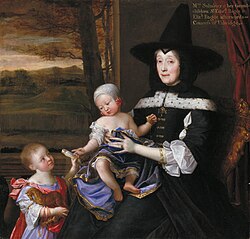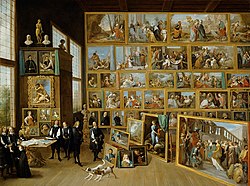John Michael Wright
John Michael Wright (May 1617 – July 1694)[2] was a British portrait painter in the Baroque style.
Wright was taught in Edinburgh by the Scots painter George Jamesone. He became a famous artist and scholar during his long journey in Rome. There, he entered the Accademia di San Luca, and came to know some of the most important artists of his time. He was hired by Archduke Leopold Wilhelm of Austria, the governor of the Spanish Netherlands in 1655. His job was to find artworks in Oliver Cromwell's England in 1655.
He settled in England from 1656. He served there as a court painter before and after the English Restoration. A Roman Catholic, he was favoured by the Stuart court. Hired by both Charles II and James II, he saw many of the political experiences of the era. In the last years of the Stuart rule he went back to Rome as part of an embassy to Pope Innocent XI.
Today, Wright is seen as one of the most important British painters of his time. He is important mostly because of the special realism he used in his portraits. Perhaps because of his unusual experiences, he was favoured by people of the highest level of society. This was surprising in an age in which foreign artists were usually more liked. Wright's paintings of royalty and aristocracy are in the collections of many great galleries today.
Early years and Scottish connections
John Michael Wright, who would later sign himself "Anglus" or "Scotus",[4] is of uncertain origin. The diarist John Evelyn called him a Scotsman. Horace Walpole and his later biographer, Verne, agreed with this.[5]
But in 1700, Thomas Hearne claimed that Wright was born in Shoe Lane, London. He added that after Wright became a Roman Catholic when he was an adolescent, he was taken to Scotland by a priest. A baptismal record, dated 25 May 1617, for a "Mighell Wryghtt", son of James Wright, described as a tailor and a citizen of London,[6] in London, seems to agree with this claim.[7]
John Michael Wright Media
Portrait of Mary Wilbraham, Weston Park
"The Virgin and Child" (1647) after Annibale Carracci. Wright's earliest known Scottish work, dedicated to the Marquess of Somerfield. Hunterian Collection
Archduke Leopold's Gallery in Brussels, for which Wright collected (painting by David Teniers the Younger c. 1650).
Elizabeth Claypole (1658), National Portrait Gallery
The portrait by Wright of King Charles II, in the Royal Collection
The Ladies Catherine and Charlotte Talbot (1679), Tate Collection
- This set of images was gathered by User:Dcoetzee from the National Portrait Gallery, London website using a special tool. All images in this batch have a known author, but have manually examined for strong evidence that the author was dead before 1939, such as approximate death dates, birth dates, floruit dates, and publication dates. See source website for additional information.
Notes
- ↑ "Portrait of Mrs Salesbury with her Grandchildren Edward and Elizabeth Bagot". Tate. Archived from the original on 2012-07-26. Retrieved 2008-01-09.
- ↑ exact dates are unknown, the probable date of baptism is 25 May 1617 and he was buried on 1 August 1694
- ↑ "George Jamesone, 1589 / 1590–1644. Portrait painter (Self-portrait)". National Galleries of Scotland. Retrieved 2008-01-05.
- ↑ Ferris, J.P. (March 1982). "The return of Michal Wright". The Burlington Magazine. 124 (948): 150, 153.
- ↑ De Beer, G. S. (1955). "The Diary of John Evelyn". Vertue's Note Books:Walpole Society. iii: 338–39.
- ↑ Thomas, Duncan (2004). "Wright, John Michael". Oxford Dictionary of National Biography. Oxford University Press. Retrieved 2007-12-27.
- ↑ The record was discovered by Waterhouse: Waterhouse, E. K. (1953). Painting in Britain 1530–1790. Penguin Books. pp. 70–73.
Other websites
 Media related to John Michael Wright at Wikimedia Commons
Media related to John Michael Wright at Wikimedia Commons- "John Michael Wright at the National Portrait Gallery, London". npg.org.uk. Retrieved 18 June 2010.
- "John Michael Wright at the Royal Collection". royalcollection.org.uk. Retrieved 18 June 2010.








